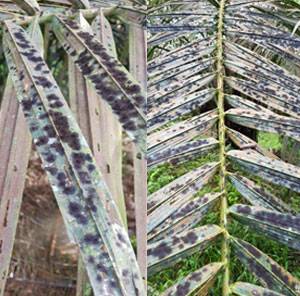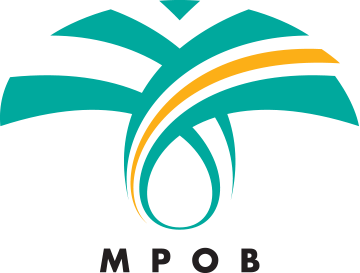Biology and Symptom
Sooty mold’s name comes from the dark threadlike growth (mycelium) of the fungi resembling a layer of soot. Sooty mold is a fungal disease that grows on plants and other surfaces covered by dark black mycelium on the upper surface or lower side of the oil palm leaves.
The disease attacks leaf of old frond oil palm. Pathogens can be seen growing on the lower or upper surface of oil palm pinnate (leaves) but do not infiltrate into leaf tissue or causing physical damage. Unlike true fungal diseases, sooty mold is easily wiped from the leaf surface.
Usually, the pathogen attack oil palm that aged more than five years after planting. High rainfall and humidity conditions will encourage the growth of the pathogen. The pathogen will not cause direct affect the production of oil palm yield but only interferes the process of photosynthesis that take places in the leaves.
Sooty mold is not a hemibiotropic fungi and do not infect and attack plants systemic response. The mold can indirectly damage the plant by coating the leaves where the sunlight can’t reach the leaf surface. Without adequate sunlight, the plant’s ability to carry on photosynthesis is reduced and disturbed, which can stunt plant growth. Coated leaves also might cause the leaves to yellowing, prematurely age and die, causing premature leaf drop. It may also reduce the quality of oil palm fruit set.

Causal
Several pathogens of the oil palm sooty mold are identified as Meliola elaeidis (Afrika); Brooksia tropicalis (Africa, Sabah, PNG); Ceramothyrium sp. (Sabah) and Capnodium sp (Thailand). Other fungi that related to sooty mould fungi in other crops are Limacinula samoenesis (coconut); Microxiphium spp. (chilli, coconut, oil palm); Trichomerium spp. (coconut, oil palm), Ripospermum gardneri (oil palm, cocoa). Other fungal genera recorded are Antennulariella, Limacinula and Parascorias.
The disease also can be spread through spores released by the fungus through wind, rainwater or vectors such as koya, aphid, mealybug, scale or whitefly. These insects’ vectors may carry the mycelium spores to the plants.
Disease Management and Control
The infected oil palm leaves should be removed and prune to prevent them from spreading to other healthy leaves. Adequate ventilation and sunlight in the field should be emphasized so that it reaches all parts of the palm leaves.
Heavy infestation with vector such as koya, aphid, mealybug, scale or whitefly should be killed by using suitable pesticides such as white oil, neem oil or horticultural oil. Spay in early evening after oil palm is no longer in direct sunlight because these oils can exaggerate the effects of sun and risk of sunburning the leaves. Spray with solution of dishwashing soap to cleaning up the mold and killed some pests that cause sooty mold. Always follow the directions when using any pesticide. A proper pest management need to be considerate as to treat the oil palm against these pests.
